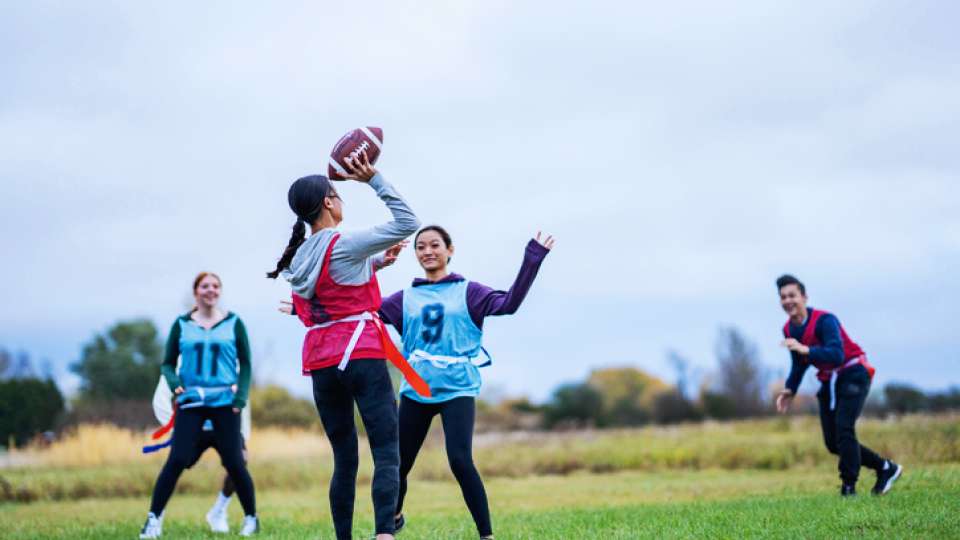
If, after the thrilling Super Bowl LVIII, you can’t believe football (and spying on Taylor Swift watching football) won’t be coming back for seven months, there is good news: a non-contact alternative is starting its spring season. And it will appeal to both longtime lovers of the sport as well as their kids who just got into it because of, well, Taylor Swift: enter flag football.
You might remember it from summer camp or middle school PE class: teams of five try to get the football into the endzone by passing and running with it, but instead of tackling to stop someone, defensive players yank one of the flags hanging off the person with the ball.
The sport is having a moment. According to the International Federation of American Football (IFAF), 2.4 million kids and teenagers play flag football in the U.S., many in leagues sponsored by the NFL. The Seattle area boasts several such youth leagues, and college and adult leagues exist, too. The IFAF holds flag world championships, and, to top it all off, the 2028 Olympic Games in Los Angeles will include the sport for the first time.
Intrigued? Here are some more reasons flag has become such a thing again.
It’s much safer than tackle football
As awareness about the long-term impacts of traumatic brain injuries has grown, many parents have had second thoughts about signing their children up for tackle football. The sport has the highest number of sports-related concussions for young people in the US, which can result in everything from temporary headaches to permanent changes in personality and mental health issues.
While flag football carries the risks of running around a grass field — think ligament injuries, ankle sprains, etc. — it’s a lot safer when it comes to traumatic brain injuries.
“Because of its non-contact nature, you really shouldn’t have a lot of head-to-head contact from other players,” says Dr. Mia Hagen, an associate professor in orthopedic surgery at the University of Washington School of Medicine, while pointing out players could still suffer concussions from falls or collisions on the field.
Not only is tackling not allowed in flag, but other rules eliminate many of the plays that in traditional football most often lead to collisions. The numbers bear this out: Youth athletes in traditional football sustain 15 times more head impacts than those in flag.
It’s a low-equipment sport
While traditional football requires expensive pads, helmets and other gear, you don’t need a whole lot for flag.
“It’s a low-equipment sport,” says Hagen. “You need a team, a field, a ball, something as a flag. That’s about it.”
The field is also about half the size of a traditional gridiron, making it easier to find space to play on.
It’s accessible to all genders
Flag boasts much more gender diversity than traditional tackle football.
“You see a lot of younger women playing the sport, which you don’t see in tackle football,” says Hagen.
The IFAF holds a women’s world flag championship, in addition to a men’s, and high school flag has seen a 40 percent increase in girls playing the sport.
It’s accessible to people of all body sizes
It’s also more inclusive of different body types.
“You don’t need to be the biggest kid on the field to be successful in the sport,” says Hagen.
Instead of brute force, success in flag requires speed and athleticism.
It’s a fun way to get exercise
More than anything, it’s a great way to experience a team sport, get cardiovascular exercise and build flexibility, balance and strength. If you’re curious, don’t be intimated: Tie some flags on your belt and jump in.
A version of this story originally appeared on the UW Medicine Newsroom.

 Healthy ideas for your inbox
Healthy ideas for your inbox





